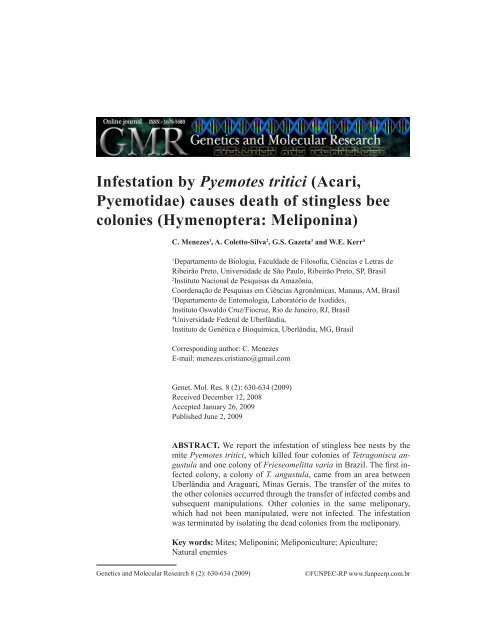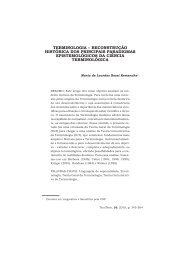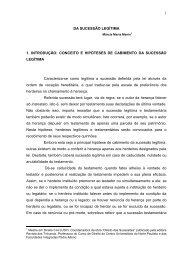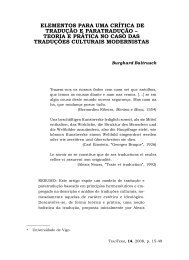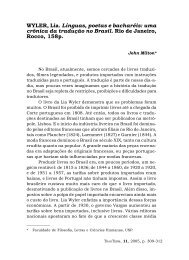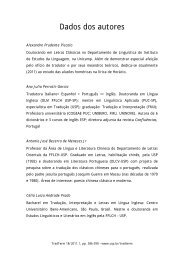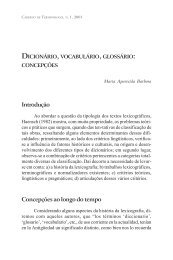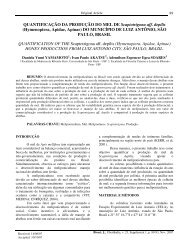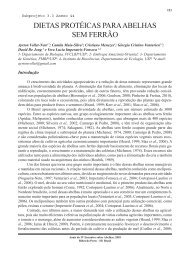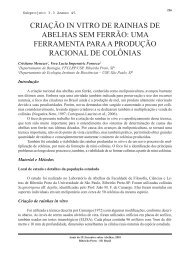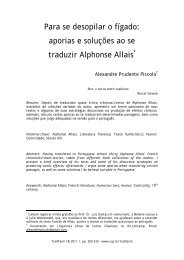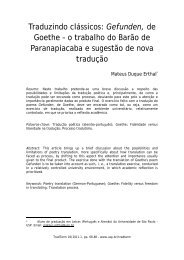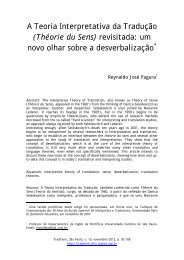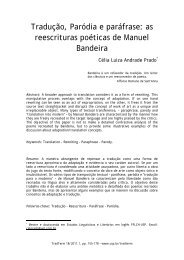Infestation by Pyemotes tritici (Acari, Pyemotidae) causes ... - USP
Infestation by Pyemotes tritici (Acari, Pyemotidae) causes ... - USP
Infestation by Pyemotes tritici (Acari, Pyemotidae) causes ... - USP
You also want an ePaper? Increase the reach of your titles
YUMPU automatically turns print PDFs into web optimized ePapers that Google loves.
<strong>Infestation</strong> <strong>by</strong> <strong>Pyemotes</strong> <strong>tritici</strong> (<strong>Acari</strong>,<br />
<strong>Pyemotidae</strong>) <strong>causes</strong> death of stingless bee<br />
colonies (Hymenoptera: Meliponina)<br />
C. Menezes 1 , A. Coletto-Silva 2 , G.S. Gazeta 3 and W.E. Kerr 4<br />
1 Departamento de Biologia, Faculdade de Filosofia, Ciências e Letras de<br />
Ribeirão Preto, Universidade de São Paulo, Ribeirão Preto, SP, Brasil<br />
2 Instituto Nacional de Pesquisas da Amazônia,<br />
Coordenação de Pesquisas em Ciências Agronômicas, Manaus, AM, Brasil<br />
3 Departamento de Entomologia, Laboratório de Ixodides,<br />
Instituto Oswaldo Cruz/Fiocruz, Rio de Janeiro, RJ, Brasil<br />
4 Universidade Federal de Uberlândia,<br />
Instituto de Genética e Bioquímica, Uberlândia, MG, Brasil<br />
Corresponding author: C. Menezes<br />
E-mail: menezes.cristiano@gmail.com<br />
Genet. Mol. Res. 8 (2): 630-634 (2009)<br />
Received December 12, 2008<br />
Accepted January 26, 2009<br />
Published June 2, 2009<br />
AbStrACt. We report the infestation of stingless bee nests <strong>by</strong> the<br />
mite <strong>Pyemotes</strong> <strong>tritici</strong>, which killed four colonies of Tetragonisca angustula<br />
and one colony of Frieseomelitta varia in Brazil. The first infected<br />
colony, a colony of T. angustula, came from an area between<br />
Uberlândia and Araguari, Minas Gerais. The transfer of the mites to<br />
the other colonies occurred through the transfer of infected combs and<br />
subsequent manipulations. Other colonies in the same meliponary,<br />
which had not been manipulated, were not infected. The infestation<br />
was terminated <strong>by</strong> isolating the dead colonies from the meliponary.<br />
Key words: Mites; Meliponini; Meliponiculture; Apiculture;<br />
Natural enemies<br />
Genetics and Molecular Research 8 (2): 630-634 (2009)<br />
©FUNPEC-RP www.funpecrp.com.br
IntroduCtIon<br />
Genetics and Molecular Research 8 (2): 630-634 (2009)<br />
<strong>Pyemotes</strong> <strong>tritici</strong> <strong>causes</strong> death of stingless bee colonies<br />
Harmonic interactions between mites and stingless bees are known from the scientific<br />
literature (Flechtmann and Camargo, 1974; Alford, 1975; Delfinado-Baker et al., 1983;<br />
Nogueira-Neto, 1997). Some of these authors suggest that certain species of mites help bees to<br />
clean the nest, control other mite populations, or even eliminate pathogenic fungi.<br />
Recently, two reports on mortal infestation of stingless bee colonies of Melipona (Hymenoptera,<br />
Apidae, Meliponini) <strong>by</strong> <strong>Pyemotes</strong> <strong>tritici</strong> (<strong>Acari</strong>: <strong>Pyemotidae</strong>) have changed our view of<br />
harmonic relationships between stingless bees and mites. The first report was on three colonies of<br />
Melipona subnitida and M. asilvae at Jardim do Seridó, Rio Grande do Norte, Brazil, which had been<br />
infested <strong>by</strong> mites of P. <strong>tritici</strong> (Kerr et al., 1996; Nogueira-Neto, 1997). In this case, the mites killed all<br />
individuals (adults and immatures), in addition to causing itches and redness of the beekeeper’s skin.<br />
The second report registered an infestation <strong>by</strong> the same mites on M. colimana at Autlán de Navarro,<br />
Jalisco, Mexico (Macías-Macías and Otero-Colina, 2004). The authors concluded that mites were<br />
responsible for the death of the colony, which had recently been transferred from a log to a nest-box.<br />
We describe a third case of mites infesting colonies of the stingless bees Tetragonisca<br />
angustula Latreille, 1811, and Frieseomelitta varia Lepeletier, 1836, <strong>by</strong> the mite P. <strong>tritici</strong>.<br />
MAtErIAl And MEtHodS<br />
Three colonies of T. angustula came from an area between Uberlândia and Araguari,<br />
Minas Gerais, Brazil (18º47’211”S 48º08’550”W) and had been donated to the Federal University<br />
of Uberlândia in October 2005. The colonies were installed in an experimental meliponary,<br />
where about 40 colonies of various species of stingless bees were kept. There is no<br />
exact information about the methods used to transfer the nests from their natural housing to<br />
the nest boxes, but it had been done shortly before transporting them to Uberlândia. As soon as<br />
they were installed in the meliponary, the colonies were inspected and fed. All three colonies<br />
had a good number of workers and a physogastric queen, which showed normal oviposition<br />
behavior. The other two colonies, one of F. varia and one of T. angustula, were already installed<br />
in the meliponary and had been established about six months prior to our observations.<br />
During their management, the colonies that died were observed without help of special<br />
equipment. After we concluded that their death had been caused through infestation <strong>by</strong><br />
mites, all the material from these colonies was taken to the laboratory, where it was analyzed<br />
with a stereomicroscope. Photos of the infested material were made with a camera connected<br />
to the stereomicroscope. Samples containing mites were fixed in 80% alcohol solution and<br />
transferred to slides for taxonomic analyses (Flechtmann, 1973).<br />
rESultS And dISCuSSIon<br />
Approximately 25 days after installing the three new colonies of T. angustula in the<br />
meliponary, one was found dead. Its entrance tube was closed and the inner structure was<br />
intact. All adult individuals including the physogastric queen, as well as a part of the larvae<br />
and pupae, were dead, but without clear evidence of the cause of death. The only thing unusual<br />
was the presence of very tiny roundish and whitish structures on the dead individuals<br />
(Figure 1A). The storage pots were intact and still contained honey and pollen. As we did not<br />
631<br />
©FUNPEC-RP www.funpecrp.com.br
Genetics and Molecular Research 8 (2): 630-634 (2009)<br />
C. Menezes et al.<br />
consider the possibility of a mite infestation at that time, those parts of the combs that still<br />
contained living pupae were transferred to another colony of T. angustula (Figure 1B).<br />
Figure 1. <strong>Pyemotes</strong> <strong>tritici</strong> parasitizing the individuals of a colony of Tetragonisca angustula. A. Mites parasitizing<br />
at inter-segmental areas of an adult worker. b. Cells of an infested comb were opened to show the mites on pupae.<br />
C. Physogastric mites parasitizing a larva. d. Physogastric mites parasitizing a pupa. E. A young mite parasitizing<br />
a pupa seen from the side.<br />
632<br />
©FUNPEC-RP www.funpecrp.com.br
Genetics and Molecular Research 8 (2): 630-634 (2009)<br />
<strong>Pyemotes</strong> <strong>tritici</strong> <strong>causes</strong> death of stingless bee colonies<br />
Three days later, the colony that had received the combs was also found dead and<br />
the same characteristics as described above were observed inside the hive. Again, the<br />
combs that contained living pupa were introduced into two other colonies of T. angustula.<br />
Both of them were found dead the next day.<br />
A colony of F. varia, which had been manipulated in the meantime, also died. In<br />
this case, however, there had been no transfer of material from the infected colonies. We<br />
concluded that, in this case, the contamination of the colony happened through mites on<br />
the beekeeper’s hands. Besides these five colonies, no further colony of the meliponary<br />
was affected.<br />
The taxonomic analyses revealed that the mite P. <strong>tritici</strong> had infested the bee colonies.<br />
This is the same species that infested and killed the colonies of stingless bees in the<br />
other registered cases in Northeastern Brazil and in Mexico (Kerr et al., 1996; Nogueira-<br />
Neto, 1997; Macías-Macías and Otero-Colina, 2004).<br />
This mite definitely caused the death of the bee colonies. This conclusion is supported<br />
<strong>by</strong> many types of evidence found in all dead colonies: lack of remnants of other<br />
natural enemies, such as ants, cleptoparasitic bees or phorid flies; the dead bees were not<br />
injured (Figure 1A); the entrance tube and the inner structure of the colony were intact;<br />
many food storage pots were still closed; the number of adult bees before the infestation<br />
was certainly large enough to maintain the colony.<br />
The sex ratio of P. <strong>tritici</strong> offspring is 1-5% males and 95-99% females, and each<br />
female can produce 200-250 new individuals (Bruce, 1984; Bruce and Wrensch, 1990).<br />
The quick proliferation, which takes four days from adult to adult, and the sex-ratio,<br />
which benefits the production of females, allow small populations to expand to thousands<br />
of individuals in a few weeks. We cannot be sure how long it took the first colony to die<br />
and at what time it had been infected. But because the initial population of mites might<br />
have been smaller, it might have taken longer than in the following colonies, which were<br />
probably infected <strong>by</strong> a huge number of mites when we transferred the combs.<br />
The mites were parasitizing both adult bees and immature individuals (pupae and<br />
larvae) (Figure 1C, D and E). Yet, the mite concentration was higher on the larvae and the<br />
pupae than on the adult bees. Probably this is because the mites were concentrated at the<br />
inter-segmental areas of the adult bees, instead of being distributed over the entire body,<br />
as was the case on the larvae and pupae.<br />
There is very little knowledge about the relationship between <strong>Pyemotes</strong> and bees<br />
(reviewed <strong>by</strong> O’Connor and Klimov, 2004). These mites have been reported to parasitize<br />
solitary bees of the Anthophoriidae and Megachilidae families. However, in addition to<br />
the other two reports on stingless bees (Kerr et al., 1996; Nogueira-Neto, 1997; Macías-<br />
Macías and Otero-Colina, 2004), there are also reports of these mites parasitizing Apis<br />
mellifera and A. cerana. The most severe case happened in Queensland, Australia, where<br />
<strong>Pyemotes</strong> mites caused the death of 19 colonies of A. mellifera (Veitch, 1936 apud Morse,<br />
1978).<br />
Apparently, the natural dispersion of the mites is restricted, since, besides those<br />
colonies that had been manipulated, no other colonies in the surrounding area were contaminated.<br />
The same happened in the other two cases reported for stingless bees (Kerr et<br />
al., 1996; Nogueira-Neto, 1997; Macías-Macías and Otero-Colina 2004). Isolating the<br />
infested colonies obviously is the most convenient solution to control infestation.<br />
633<br />
©FUNPEC-RP www.funpecrp.com.br
ACKnoWlEdGMEntS<br />
Genetics and Molecular Research 8 (2): 630-634 (2009)<br />
C. Menezes et al.<br />
We thank Dr. Francis L.W. Ratnieks, Dr. Hayo H.W. Velthuis and Dr. Vera L. Imperatriz-Fonseca,<br />
as well other colleagues from the Genetics Laboratory of Uberlândia<br />
(INGEB-UFU) and from Ribeirão Preto (FFCLRP-<strong>USP</strong>) for their valuable suggestions,<br />
and Dr. Michael Hrncir for helping in the translation of this report. We also thank Consórcio<br />
Capim Branco de Energia (CCBE) for the donation of the stingless bee colonies.<br />
Publication supported <strong>by</strong> FAPESP (#07/50218-1).<br />
rEFErEnCES<br />
Alford DV (1975). Bumblebees. Davis-Poynter Ltd., London.<br />
Bruce WA (1984). Temperature and humidity: effects on survival and fecundity of <strong>Pyemotes</strong> <strong>tritici</strong> (<strong>Acari</strong>: <strong>Pyemotidae</strong>).<br />
Int. J. Acarol. 11: 135-138.<br />
Bruce WA and Wrensch DL (1990). Reproductive potential, sex ratio, and mating efficiency of the straw itch mite (<strong>Acari</strong>:<br />
<strong>Pyemotidae</strong>). J. Econ. Entomol. 83: 384-391.<br />
Delfinado-Baker M, Baker EW and Roubik DW (1983). New genus and species of Hypoaspidinae (<strong>Acari</strong>: Laelapidae)<br />
from nests of stingless bees. Int. J. Acarol. 9: 195-203.<br />
Flechtmann CHW (1973). Ácaros de Importância Médico Veterinária. Biblioteca Rural, Livraria Nobel S.A., São Paulo.<br />
Flechtmann CHW and Camargo CA (1974). <strong>Acari</strong> Associated With Stingless Bees (Meliponidae, Hymenoptera) from<br />
Brazil. Proceedings of the International Congress of Acarology, Saafelden, 315-319.<br />
Kerr WE, Carvalho GA and Nascimento VA (1996). Abelha Uruçu, Biologia, Manejo e Conservação. Coleção Manejo da<br />
Vida Silvestre. Fundação Acangaú, Belo Horizonte.<br />
Macías-Macías JO and Otero-Colina G (2004). <strong>Infestation</strong> of <strong>Pyemotes</strong> <strong>tritici</strong> (<strong>Acari</strong>: <strong>Pyemotidae</strong>) on Melipona colimana<br />
(Hymenoptera: Apidae: Meliponinae): a case study. Agrociencia 38: 525-528.<br />
Morse RA (1978). Honey Bee Pests, Predators, and Diseases. Cornell University Press, Ithaca.<br />
Nogueira-Neto PN (1997). Vida e Criação de Abelhas Indígenas sem Ferrão. Nogueirapis, São Paulo.<br />
O’Connor B and Klimov P (2004). Family <strong>Pyemotidae</strong> Berlese, 1987. Available at [http://insects.ummz.lsa.umich.edu/<br />
beemites/Species_Accounts/<strong>Pyemotidae</strong>.htm]. Accessed June 15, 2007.<br />
634<br />
©FUNPEC-RP www.funpecrp.com.br


